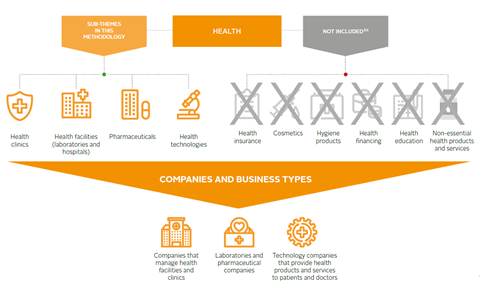
Access to health services and products is a basic human right as per the UN’s central mission; the UN created the World Health Organisation (WHO) to help countries create policies, programmes and initiatives targeting safe, affordable and accessible health services and products to individuals in emerging, developing and developed countries.
Health is also linked to economic development; not only do investments in health reduce mortality rates and increase life expectancies, they also help to boost productivity. Indeed, every $1 invested in education from now through 2035 would yield $9 to $20.
In addition, a recent study on the SDGs and health systems points out that “an additional $274 billion spending on health is needed per year by 2030 to make progress towards the SDG 3 targets (progress scenario), whereas US$371 billion would be needed to reach health system targets in the ambitious scenario”.
While the investment opportunity in this field is enormous for private organisations, most health systems, programmes and initiatives are under the supervision and responsibility of national and regional governments, and the private sector must comply with country regulations and norms.
“The Market Map is valuable because it provides standardised and well-structured guidance. It is ideally suited for regulated professionals or organisations with strong compliance requirements. It complements other approaches that are descriptive and highly customisable, which although may offer very specific insights, do not always produce comparable data about impact”.
Karl H Richter, Advisor, United Nations Development Programme
Countries use UN principles (including the SDGs) and WHO approaches/principles to tailor their own health policies and initiatives. Some countries, such as the UK, the Netherlands, Austria and Argentina, provide free healthcare services to their population, whereas the US and Chile take a more market-based approach (i.e. private healthcare). Every country has its own definition, policies and programmes to support private sector investments in healthcare.
In addition, investments and companies in the health sector are diverse and have different objectives and goals. A company can provide affordable medicine to clinics in developing countries, while another company engages in building and managing a hospital under a public-private partnership (PPP) model. Other companies only invest their capital in R&D to support further studies and research on diseases.
Access to health services and products can therefore involve different definitions, concepts and practices. Some organisations may consider soap and shampoo as basic health products, while others include water services as a health service. As a result, many organisations, including private impact investing companies, adopt different definitions that are not supported by major international organisations and UN bodies.

The difficulty in mapping health companies that meet the WHO’s goals and the PRI’s approach to mainstream impact investing is caused by varying definitions of health, as well as the scope and nature of health products, services, technologies and infrastructure.
To better frame this theme, the PRI reviewed almost 100 documents produced by the WHO, the World Bank, UN agencies and other multilateral organisations and recognised foundations. The PRI framed health services based on the WHO’s principles and the SDGs, meaning this methodology targets health investments that focus on providing basic, affordable, safe and sustainable investments in health to individuals, particularly marginalised groups and low income individuals and families.
In addition, the Market Map includes the WHO’s official list of essential medicines, treatments and medicines (including R&D) targeting pandemic and epidemic diseases, global burden diseases, healthcare facilities (including hospitals and basic health facilities) and technological products that address one or more of the diseases listed by the WHO.
Based on the information above, mainstream hospitals (for-profit only) and insurance services were not included in this methodology. While the PRI appreciates the value of health insurance products to low income and marginalised groups, insurance is not covered in the WHO’s principles, universal care definitions and in the SDGs. The PRI may develop a thematic investment category for insurance services in future versions of the Market Map.
Definition: Health
Companies that serve the population with access to good quality services, health workers, medicines and technologies. To achieve these goals, when applicable, companies should provide equity in access to health services, quality of health services should be measurable, and, most importantly, companies should actively provide affordable services, products and technologies that will not create hardship or impoverishment from health cost.
WHO
Download the full report
-

Impact investing market map
August 2018
Impact investing market map
- 1
- 2
- 3
- 4
- 5
- 6
- 7
- 8
- 9
- 10
- 11
 Currently reading
Currently readingHealth
- 12



















